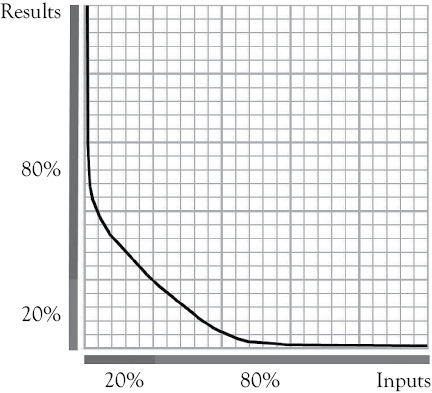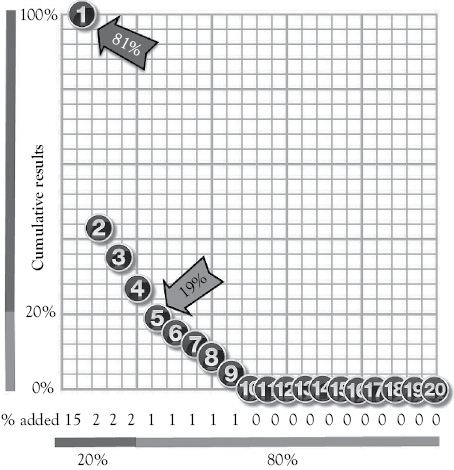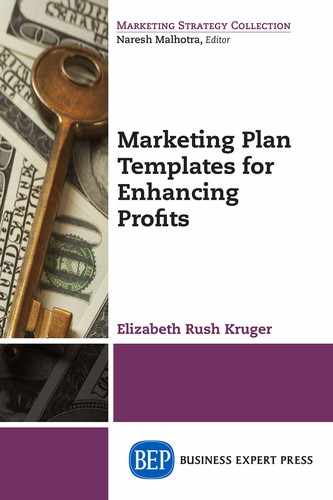Target Market: Describe Key Customers
Overview
The American Machine and Foundry (AMF) bought Harley-Davidson. In its greed for more customers, AMF reduced Harley’s price and quality, but Willie G. Davidson saved Harley from bankruptcy by delighting its key customers and attracting highly profitable new customers. As a result, Harley restored its legendary reputation and regained its profitability.
Aesop admonishes, “In their hunger for wealth, greedy people destroy what they already value.” Every business is blessed with a wealth-producing asset—customers who are loyal, heavy users. However, greedy entrepreneurs neglect their most profitable customers.
Instead, delight key customers and the business will be delighted with its profits. Let’s learn to predict how valuable key customers are and how threats limit a business.

1936 Harley-Davidson1
Vignettes
Harley-Davidson Restores a Legend
Prior to and during the world wars, Harley-Davidson prospered from its legendary reputation. In 1969, the AMF bought the company. AMF decided to compete for customers with cheap Japanese motorcycle brands. In its greed for more customers, AMF reduced Harley’s price and quality, thereby tarnishing its reputation, and Harley slid toward bankruptcy.2
Twelve years later, Willie G. Davidson, grandson of the cofounder, and other investors saved Harley-Davidson from bankruptcy. They noticed that Harley’s most profitable customers were intensely loyal to its products. Harley delighted these key customers with retro American styling, branded accessories, and events sponsored by Harley Owner Groups (HOG). As a result, Harley restored its legendary reputation, attracted highly profitable new customers, and regained its profitability.3
Is Haste a Waste?
An Aesop Fable
A Greek god rewards a worshiper with a goose. The man grumbles to his wife, “Why did Hermes give us a goose?” The next morning he discovers why—the goose laid a golden egg! Awaking the next day with great anticipation, the man finds another golden egg.
Day after day he finds a golden egg. Eventually, his gratitude sours into a feeling of entitlement. “Why must I wait for wealth to come in driblets? The inside of the goose must be solid gold!”
Hastily, he slaughters the goose and opens up its belly. To his horror, all he finds is blood and guts like any ordinary bird. Bewailing his fate, he sobs, “Woe is me. I’ve killed the goose that laid golden eggs.”
Aesop advises that haste is a waste. “In their hunger for wealth, greedy people destroy what they value.”
Key Customers Lay Golden Eggs
Every business is blessed with a wealth-producing asset—its loyal, heavy users. Cherish the most profitable customers and they will keep laying golden eggs year after year. A business that delights its key customers can easily attract highly profitable new customers.
Aesop says, greedy ones have much, yet want more. In their hunger for more customers, they neglect their most profitable customers. Greedy entrepreneurs assume that “our most profitable customers will always buy from us,” but their neglect may drive them to competitors.

CVS Caremark outlet4
Was I a Goose?
A marketing research company in Milwaukee hired me to sell its research projects and agreed to pay me a salary plus a 10 percent sales commission. During my first week on the job, I called my prior client at CVS/Caremark.
The company manages prescription benefits for large employers. Instead of needing marketing research, I discovered that Caremark needed employee research. Caremark planned to evaluate employee satisfaction with its services. As my client admired my previous work, he asked me to present the capabilities of my new employer to its Board of Directors.
The owner of the marketing research company said, “We have conducted customer satisfaction studies for many years.”
I added, “Our experience prepares us to measure employee satisfaction with Caremark’s management of prescription benefits.”
The owner said, “Most of our clients are banks.”
I added, “Since I have conducted several marketing research projects for Caremark, I understand the business and how you benefit your clients. I can easily conduct employee satisfaction studies for you.”
The owner said, “Our customer satisfaction studies typically show that ninety-eight percent of the customers are delighted with our clients’ services.”
I added, “Based upon our experience, Caremark can expect employees of its clients to be delighted with your management of their prescription benefits.”
After the presentation, my client expressed his delight with my responses. He asked me how long I had worked there and I said, “Only two weeks.”
My client whispered in my ear, “The owner better watch out. In another year, you’ll be the owner of his company.”
Following the meeting, Caremark contracted with each of its clients for annual employee evaluations of its services. The owner realized that his company would greatly profit from these research projects and Caremark would become one of its key customers.
Within a few weeks, I sold some other highly profitable research projects. In total, I earned $78,000 in sales commissions. Instead of paying me, the owner fired me. When my clients learned this, they canceled their contracts. Did the owner realize that he killed a goose that laid golden eggs?
How Valuable Are Key Customers?
Should You Treat Customers Equally?
No, compared to others, some customers are much more valuable to the business because it is more valuable to them. Delight the key customers and the business will be delighted with its profits.
The 80/20 rule predicts that the top 20 percent of customers will produce 80 percent of the profits, thereby generating four times more profits than expected. In contrast, the bottom 80 percent of customers will produce 20 percent of the profits, thereby generating only a quarter of what is expected (Figure 2.1 and Table 2.1).5

Figure 2.1 Profitability of customers
Table 2.1 Profitability of customers
|
Customers |
Inputs |
Results |
Return |
|
Top |
20% |
80% |
4-fold |
|
Bottom |
80% |
20% |
0.25-fold |
What Is the Pareto Distribution?
You learned the 80/20 rule predicts that the top 20 percent of inputs will produce 80 percent of the results and vice versa. Are you curious about the other inputs? Pareto was also curious, so he related inputs to their results by plotting data points on graph paper. He discovered the data points traced the same distribution, a smooth concave curve that scientists posthumously called the Pareto distribution. After extensive research, Pareto concluded the distribution consistently predicts results. Virtually, any large random sample of input and output data will trace the Pareto distribution (Figure 2.2).6

Figure 2.2 The Pareto distribution
Do you remember our sample of 20 people? I was embarrassed about owning 15 hats because many did not own a hat. Yes, even this tiny sample closely traces the Pareto distribution. The data line in Figure 1.1 is a mirror image of the Pareto distribution in Figure 2.3. If we had a larger sample, there would be fewer gaps at the higher end of the curve (Figure 2.3).7

Figure 2.3 The distribution of hats
Key #2: Describe Key Customers

Peter F. Drucker8
The aim of marketing is to know and understand the customers so well the product or service fits him and sells itself.
Peter F. Drucker, developer of management by objectives, management consultant and author, 1909–2005.
What Are the Steps in Describing Key Customers?
- Select an unbiased sample of a 100 customers of the business. The sample will represent the diversity of its customers.
- Evaluate the profitability of each customer in the sample. The most profitable 20 customers in the sample will represent the most profitable 20 percent of the customers.
- Interview these key customers until you understand their purchase motivations and buying processes. Learn how they differ from other customers and profile their typical traits.

Harley-Davidson bikers9
For example, the key customers of Harley-Davidson tend to be mature American white men with a technical profession who identify with the Harley lifestyle and glory in their conservative values. They usually socialize with other Harley enthusiasts, customize their bikes, and borrow money to upgrade them. After describing its key customers, Harley decided to delight these key customers with retro American styling, branded accessories, and events sponsored by HOG.
How Do Threats Limit the Mission?
Threats limit the ability of the business to fulfill its mission. As with opportunities, there are six types of threats facing a business. These are some examples of how global trends can limit business opportunities.
What Threats Are Trending?
Demographic Trends
- More employees request Family Medical Leave to care for their elderly relatives.
- Businesses that lack bilingual skills have fewer prospects.
Economic Trends
- Businesses that target unemployed people and those on fixed income are struggling to earn profits.
- Inflation cuts profits for businesses that hold costly inventory.
Natural Trends
- Vehicle manufacturers must find ways to lower air pollution and increase mileage.
- Facilities with swimming pools are spending more for water.
- Coal-burning factories must invest in air purification or switch to a cleaner source of energy.
Technological Trends
- People are buying fewer landline services, analog machines, encyclopedias, dictionaries, and maps.
Political
- Advertising is more expensive during political campaigns.
- Embargos are blocking the free trade of goods and services.
Cultural
- More businesses must provide daycare and flexible work schedules.
- In some countries, Muslim communities require non-Muslim businesses and government services to leave the area.
Summary
Every business is blessed with a wealth-producing asset—its loyal, heavy users. Delight these key customers and the business will be delighted with its profits. The Pareto distribution predicts that the top 20 percent of customers will produce 80 percent of the profits, thereby producing four times more profit than expected.
As with opportunities, there are six types of threats facing a business. The business describes its target market as key customers who remain despite threats. The second key to enhancing profits is to describe the most profitable customers of the business.
 Describe Key Customers
Describe Key Customers
Profile the typical traits of key customers on the most important aspects of their demographics, lifestyle, and buying behavior. Consider these traits:
Demographic Traits
Role in the purchase process
□ Decider |
□ Influencer |
□ User |
Personal traits
□ Education |
□ Language |
□ Race |
Employment
□ Category |
□ Income |
□ Industry |
Home
□ Location |
□ Own or rent |
□ Stability |
Household
□ Age of youngest child |
□ Others |
□ Spouse |
Psychographic Traits
Activities
□ Memberships |
□ Subscriptions |
□ Hobbies |
Priorities
□ Attitudes |
□ Interests |
□ Values |
Passages
□ Life stage |
□ Aspirations |
□ Risks and fears |
Buying Behavior
Search process
□ Length |
□ Influences |
□ Complexity |
Criteria
□ Features |
□ Benefits and values |
□ Motive |
Timing
□ Catalyst |
□ Timing |
□ Frequency |
Describe key customers of the business and profile their typical traits.
